3 Most Used Type Of Egg Poachers – It’s Working And Other Uses
Regular eggs can get tiring for breakfast. So it’s always a good idea to throw in a twist occasionally, like poached eggs. They make an excellent addition to your mornings. However, many people don’t choose to make it at home, thinking it’s a complicated process. Not to worry, I’ve got you covered with all the types of egg poachers and the way they work.
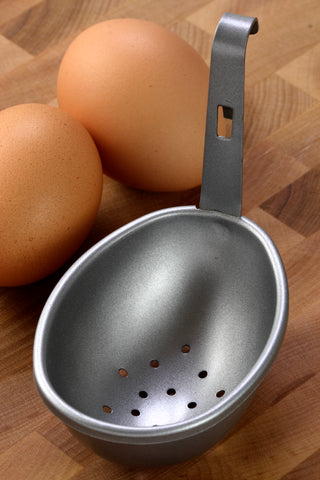
Photo by rafer76 / Depositphotos
Egg poachers are utensils that help cook the egg whites, sparing the egg yolk. These are called poached eggs and are a common addition to breakfast. Egg poachers are incredibly flexible and can double as instruments to cook other dishes like muffins, steaming wontons or dimsums, and even small bite-sized cakes. Use fresh eggs for poaching as they bring foolproof results.
Egg poachers come in different forms, and each one of them works differently to serve the same purpose: to poach eggs. Microwave, silicone, and stovetop egg poachers are most commonly used for this purpose. Most of these egg poachers do not take too long and can finish poaching the eggs between 2 to 8 minutes based on the type and model of the egg poacher.
HOW DO MICROWAVE EGG POACHERS WORK?
The older, conventional ways of egg poaching may end up in multiple disasters and may seem daunting. It may stick to the pan or even come apart while taking it out of the pan unless extremely careful. The microwave method of egg poaching is relatively easy, less messy, and can be done within two minutes – it is as simple as that.
Many different brands offer microwave egg poachers, and though they might have slight differences, they work very similarly. Make sure to read the instructions given in the manual to check the optimal level of heat usage and precautions to be taken.
COAT EGG CUPS – The first step in poaching an egg is to coat the egg cups with cooking spray, butter, or oil to prevent sticking to the cup. A non-stick spray can also be used. Use it to coat it thoroughly as a thin sheet.
CRACKING THE EGG – Crack an egg and pour the contents into an egg cup. Most of the egg poachers come with a double cup design. So, if you want to make only one poached egg, fill 3/4th of the other cup with water. Set the microwave’s temperature based on your model and the manual.
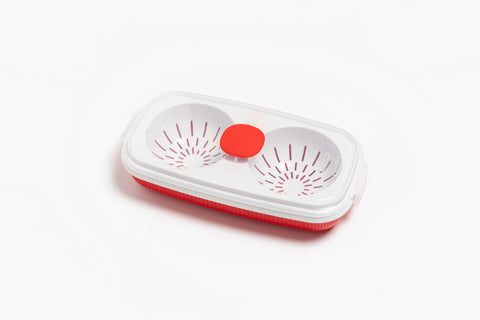
Photo by sabirio.mail.ru / Depositphotos
PIERCING THE YOLK – While in the egg cup, use a sharp instrument like a knife or fork to pierce the yolk once. This will prevent the yolk from exploding under the high temperatures of the microwave poacher.
WATER – Add about ½ tsp of water on top of the eggs in each cup. This is done so that the egg cooks evenly on the top, as the boiling water helps cook the egg.
TIME – Cook it in 30-second intervals for one egg and 60 seconds for two eggs. Check if the egg is thoroughly cooked. If it isn’t, place it back for another 30 seconds.
Sometimes the finished egg might not look entirely satisfactory, and if that is the case, flip them. It helps the egg cook and look better. However, this can be tricky as you will have to flip it in that small space. So, be cautious not to burn yourself.
Let the eggs rest for about 30 seconds after removing them to finish cooking. This is a quick and effective way to poach eggs for days when you need something different in your morning routine.
SILICONE EGG POACHER
Silicone utensils are heat-safe and freezer-safe utensils that have been gaining a new high in the markets these days. They are not only convenient but also safe to use. You will be glad to know that egg poachers are also available in this material.
Silicone egg poachers come in pods, and they are slightly expensive, but they prove their worth as they are convenient and easy to handle with good results. To poach an egg with this, follow these steps :
COAT SILICONE PODS – Coat the eggs with a lubricant like butter or oil to ensure the eggs do not stick to the pods. Cooking spray or non-stick spray will work wonders too.
BEGINNING THE PROCESS – Crack an egg into each pod, place it in about 2-3 inches of boiling water in a wide-mouthed vessel, and put a lid on it.
TIME – Cook for up to 5-6 minutes based on how cooked you like it. You can cook up to four eggs at a time. Use a knife to remove the egg from the pod if it is stuck to the pod. Be careful while taking them out as it might be hot.
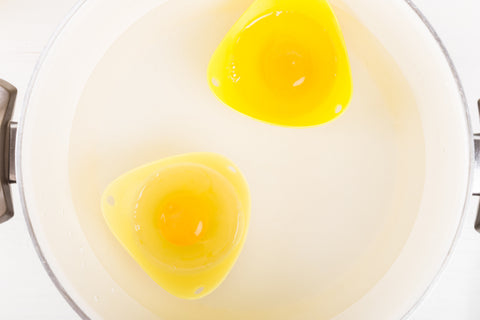
Photo by MAnuta / Depositphotos
THE WORKING OF A SILICONE EGG POACHER :
Most silicone egg pods also come with the label “microwave safe.” It works the same way as putting the pods in water. Some of these pods even come updated with handles for easy maneuver. First, add some cooking spray or butter for the egg to slip after cooking. Now, crack the egg into the pod, poke the yolk, and put it in the oven. Your egg will be poached in a matter of a few minutes.
Even though it takes slightly longer than microwave egg poachers, it guarantees similar results.
HOW DOES A STOVETOP EGG POACHER WORK?
The stovetop egg poacher is a little more traditional way of poaching eggs. It has a pan with marked, dented areas for the eggs. This is floated on hot water to cook them. Using this utensil can be a little more tricky.
SIMMERING WATER – The first step is to bring about ½ inch of water to simmer in a wide vessel of choice. Medium heat should do because you do not want it to boil too much and create a splashy mess.
CRACKING THE EGGS – Make sure to crack each egg carefully after greasing the pan with oil or butter. Crack open the eggs into the cup, but make sure not to break the yolk and fill up any unused cup with water. Place the cups in the wide pan of hot water and put the lid on. Ensure that the water touches the base of the cups.
TAKING THEM OUT – Cook them for about 3 to 5 minutes, depending on how soft you want the yolks to be. Then, use oven mitts or a cloth to gently take the cups out so that you do not burn yourself. This is the tricky part of using stovetop poachers.
To check if the eggs are poached enough, you just need to shake it up a bit. If it looks solid and pale white on the outside and the yolk jiggly and runny, it’s probably about done.
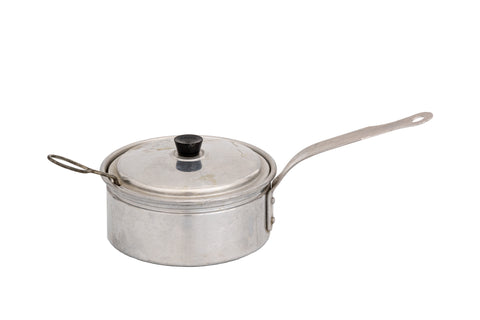
Photo by tclaxton / Depositphotos
WHICH IS THE BEST TYPE OF EGG POACHER FOR ME TO USE?
There are many different types of egg poachers available in the market. However, these three egg poaching methods and egg poachers are the most used. Even though all three techniques have their own benefits, they may not work for everyone.
- The stovetop method is good but can be difficult because of the boiling water and metal pan. It is essential to handle it as carefully as possible.
- The microwave egg poaching method is convenient but easy to go wrong with the doneness of the egg. Temperatures are critical to count and determine which one is best for you. The oven model can largely influence the temperature that needs to be set. Some microwave egg poachers come in smaller, compact styles, making them convenient to carry around.
- The Silicone egg poaching pods are also incredibly convenient as they are pocket-sized and can be carried around anywhere. They are also enduring. Some may not prefer to spend on silicone poachers as they can be expensive, but their work is impeccable.
Many people believe making poached eggs is as hard as recreating Van Gogh’s art, but it really isn’t. Experimenting with each method and finding out which strategy can work best for you is a good idea.
WHAT ELSE CAN I USE THE EGG POACHER FOR?
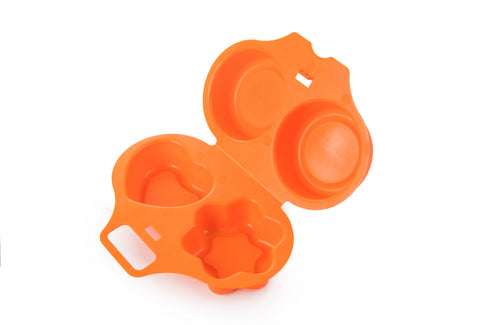
Photo by Timmary / Depositphotos
Egg poaching equipment can look like an unwanted expense for something that can only poach eggs. Luckily for us, egg poachers can, in fact, be used to prepare other dishes as well. Some familiar dishes made using egg poachers are muffins, wontons or dimsums, and mini cakes.
The small size of each egg cup in a poacher makes it convenient to try any of these dishes. The recipes remain the same, but the cooking time will predominantly reduce because of the small, bite-sized quantity.
Another easy and quick recipe to try is miniature chocolate cakes. To make these, you need flour, milk, cocoa powder, choco chips, baking powder, granulated sugar, and salt.
- Flour – ¼ cup
- Cocoa powder – 2 tablespoons
- Baking powder – 1/4th teaspoon – to make it fluffy
- Salt – Add salt – a pinch
- Sugar – preferably granulated – 2 tablespoons
- Milk – ¼ cup to add initially, then you can add more based on how thick or runny you want the batter to be.
Mix all these ingredients, pour them into the egg poaching cups, and keep them in the microwave oven. Check them after five minutes. If you want them to be more solid, you can keep them in for a couple more minutes. They are a quick bake, so be careful not to overcook and burn them.
It can also simply melt butter or chocolate as it offers small compartments that fit in. So, it is a quick and less messy solution.
WHAT ELSE CAN I EAT POACHED EGGS WITH?
Are you tired of eating poached eggs with only bread? Does bread feel too dry on some days? The main advantage of poached eggs is that they are pretty flexible, and you can eat them for breakfast, lunch, and dinner in various ways. At least one of these dishes is sure to satisfy your egg craving.
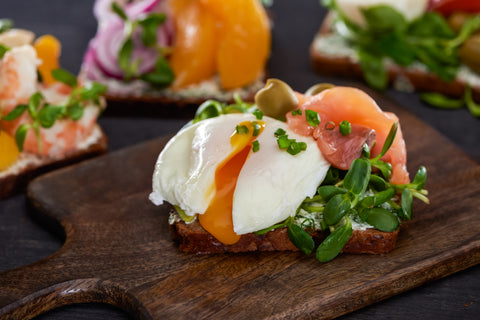
Photo by VadimVasenin / Depositphotos
- Salads – I know! Salads seem boring, but they can be absolutely delicious. Add a poached egg on top, and it becomes even more appealing. This healthy option is a quick fix for a meal when running late. Spinach salads, in particular, taste much better with poached eggs because of the complementary flavor it provides.
- Spaghettis – This family’s favorite Italian dish is almost a weekly dish in many places. Adding a poached egg to it not only contributes to the health rating of the dish but also the gooey yolk makes it creamier and tastier. This dish is a definite win among children especially.
- Eggs Benedict – Eggs Benedict is a popular brunch dish. It may seem slightly intimidating to make, but it is not really so. It is a combination of Hollandaise sauce, English muffins, and Canadian bacon, along with our poached eggs. These can actually be prepared within half an hour within the comfort of our own homes.
- Pancakes – Pancakes and eggs seem like a combination that is not likely to be good. Nevertheless, the spicy pancakes or Chorizo and Halloumi Pancakes with poached eggs make a great combination. They are also relatively quick and easy to make.
- Soups – Garlic soup with potatoes and poached eggs make an excellent dish to start your day. The meal is a healthy alternative to snacking on junk food. The soup is made better and tastier with the presence of the egg, which adds more creaminess and flavor. Adding crisps to this or on the side is a way to make this already great dish even better.
From this article, I am sure you would have picked up something that interests you and perhaps will give egg poachers a try. Egg poaching seems intimidating initially, but it is just a matter of practice and time. Sooner or later, poached eggs might become a staple at your house.
Happy cooking!!

